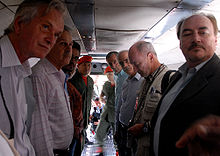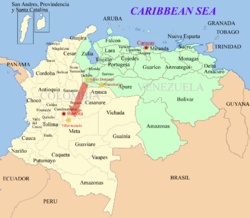- Operation Emmanuel
-
Operation Emmanuel (Spanish: Operación Emmanuel) was a humanitarian operation that rescued politician Clara Rojas, her son Emmanuel (born in captivity), and former senator Consuelo González from the Revolutionary Armed Forces of Colombia (FARC) in Colombia. The operation was proposed and set up by Venezuelan President Hugo Chávez, with the permission of the Colombian government of Álvaro Uribe. Chávez's plan was supported by the governments of Argentina, Brazil, France, Ecuador and Bolivia, as well as the Red Cross which also participated in the operation. Venezuelan aircraft were flown to an airport in the Colombian town of Villavicencio, were resupplied, and from there flew to the secret rescue point set up by the FARC.[1][2] On December 26, 2007 the Colombian government through the Minister of Foreign Affairs approved the mission; only requesting that the aircraft used for the operations were labeled with Red Cross insignias.[2]
Contents
Background
Colombian politician and then-senator Consuelo González was kidnapped by the FARC on September 10, 2001 and had since then been held by her captors, in order to pressure a possible "humanitarian exchange" between government-held guerrilla prisoners for FARC-held hostages. In 2002 former Vice Presidential candidate Clara Rojas was kidnapped along with presidential candidate Ingrid Betancourt and both also continued to be held by the FARC. While in captivity, Clara Rojas got involved in a relationship with one of her captors and had a baby as a result, who was named Emmanuel.
In 2007 Colombian policeman John Frank Pinchao escaped from his FARC captors and confirmed the existence of the relationship and of Emmanuel.
Mission
 Hugo Chavez with international guarantors of Operation Emmanuel.
Hugo Chavez with international guarantors of Operation Emmanuel.
President of Venezuela Hugo Chávez has said that the plan consists of three phases. The first phase was to send the two Mil Mi-17 helicopters to Colombia carrying five International Red Cross Committee delegates. Both helicopters are to be equipped with medical aid apt for the humanitarian mission and in accordance with International Red Cross standards. Chávez personally inspected the two helicopters in Santo Domingo before departing along with former president of Argentina Néstor Kirchner, who was also invited to supervise the operations. Besides the two Mi-17 helicopters, two Bell 412 helicopters and three French-made executive jets Falcon 200 were also used for support tasks.[3]
Along with the ICRC delegates there will be representatives from Ecuador, Brazil, Argentina, France, Cuba, Bolivia, Colombia and Switzerland. Hollywood director Oliver Stone was contacted by Chávez to film a documentary about the ordeal.
Family members of the three hostages traveled from Colombia to Caracas to wait for the end of the operation, set to conclude in Caracas with President Chávez receiving them, as previously petitioned by the FARC as a condition.
Phase I
During the first phase two Russian-made MI-17 helicopters from the Venezuelan Military Search and Rescue Team flew into Colombia on December 27, 2007 at 1530 hours with the permission of the President of Colombia and with the International Red Cross (IRC) insignia for a humanitarian mission. The helicopters flew over two hours from the Venezuelan town of Santo Domingo in the State of Táchira to the Colombian city of Villavicencio, capital of the Department of Meta, arriving at around 1730 hours.[4]
Colombia's High Commissioner for Peace, Luis Carlos Restrepo Ramírez, was scheduled to receive the IRC delegates and the Vice Chancellor for Latin America and the Caribbean, Rodolfo Sanz, in Villavicencio to coordinate the rescue operation.[4]
At the end of the first phase Colombian President Alvaro Uribe said: “[I'm] thinking about the freedom of Emmanuel, the child who was conceived by a kidnapped mother, who has been raised kidnapped, a condition worse than the conditions seen in enslaved societies […]”[5]
Phase II
On December 31, Hugo Chávez read a letter from FARC where the group claimed that the hostage release had been delayed because of Colombian military operations. Colombian President Álvaro Uribe indicated that FARC had not freed the three hostages because Emmanuel may not be in their hands anymore.[6]
Colombian authorities added that a boy matching Emmanuel's description had been taken to a hospital in San José del Guaviare in June 2005. The child was in poor condition; one of his arms was hurt, he had severe malnutrition, and he had diseases that are commonly suffered in the jungle. Having been evidently mistreated, the boy was later sent to a foster home in Bogotá and DNA tests were announced in order to confirm his identity.[6]
On January 4, the results of a mitochondrial DNA test, comparing the child's DNA with that of his potential grandmother Clara de Rojas, were revealed by the Colombian government. It was reported that there was a very high probability that the boy was indeed part of the Rojas family.[7] A further analysis will be carried out in a Santiago de Compostela institute in order to verify the procedure, which could take up to two weeks.[7][8]
Venezuelan Foreign Minister Nicolás Maduro questioned the results, stating that Colombia did not allow Venezuelan specialists to conduct their own tests and had created a "cloak of doubt".[7]
On January 4, the FARC released a communique in which they admitted that Emmanuel had been taken to Bogotá and "left in the care of honest persons" for safety reasons until a humanitarian exchange took place. The group accused President Uribe of "kidnapping" the child in order to sabotage his liberation.[9][10]
Further medical tests revealed beyond any doubt the identity of the child.
The suspended operation resumed and, on January 10, 2008, a humanitarian commission headed by the International Committee of the Red Cross flew in two Venezuelan helicopters to a location in Colombia that had been designated by FARC the previous day. Rojas and Gonzalez were then released to the care of the commission.[11] The release received ample coverage by Venezuelan government media which was allowed to take camera men in the helicopters in what was to become a carefully crafted media showcase.
On January 13, 2008, Clara Rojas was reunited with her son, Emmanuel. It was the first time in over two years that she was able to see him.[12]
See also
- Operation Jaque
- Colombia-Venezuela relations
- Opération 14 juillet
References
- ^ AP: Chavez: Colombia Hostages May Be Freed
- ^ a b (Spanish) Caracol Radio: Colombia authorizes humanitarian mission for the release of the hostages without conditions
- ^ (Spanish) El Mundo: Larga jornada de espera en Colombia para el inicio de la misión de rescate
- ^ a b (Spanish) TeleSUR: Este sábado se inicia la segunda fase de la Operación Emmanuel
- ^ (Spanish) El Universo: Se inició primera fase de rescate de rehenes
- ^ a b BBC News: Colombia tests 'hostage' boy DNA
- ^ a b c BBC News: Colombia boy may be hostage's son
- ^ (Spanish) El Tiempo: Niño en poder de Gobierno sí es el hijo de Clara Rojas; así se confirma tesis de Uribe de por qué las Farc no liberaron rehenes
- ^ BBC News: Farc admit 'hostage boy' not held
- ^ (Spanish) teleSur: FARC anuncian que Uribe secuestró a Emmanuel
- ^ www.miamiherald.com/news/breaking_news/story/373967.html
- ^ www.guardian.co.uk/colombia/story/0,,2240530,00.html
Categories:- Colombian armed conflict (1964–present)
- International Red Cross and Red Crescent Movement
- Humanitarian military operations
Wikimedia Foundation. 2010.

